Analysis of the Interaction between Lake and Groundwater Based on Water–Salt Balance Method and Stable Isotopic Characteristics
Abstract
:1. Introduction
2. Materials and Methods
2.1. Study Area
2.2. Sampling and Measurements
2.2.1. Sampling and Conservation
2.2.2. Measurements and Analysis
2.3. Study Method
3. Results and Discussion
3.1. Water and Salt Balance Analysis
3.1.1. Analysis of Equilibrium Elements of Water and Salt
- Precipitation and evapotranspiration
- 2.
- Channel recharge and discharge
3.1.2. Equilibrium Results and Contribution Rate Analysis
3.2. Analysis of Stable Isotope Characterization
3.2.1. Stable Isotope Characteristics of Different Water Sources
3.2.2. Stable Isotope Ratios for Water Exchange
3.3. Hydrochemical Characteristics
3.3.1. Seasonal Variation in Ecological Indicators
3.3.2. Interannual Variation in Ecological Indicators
4. Conclusions
Supplementary Materials
Author Contributions
Funding
Institutional Review Board Statement
Informed Consent Statement
Data Availability Statement
Acknowledgments
Conflicts of Interest
References
- Zhu, J.; Liu, Y.; Zhang, S.; Zheng, H. Review on the research of surface water and groundwater interactions. China Environ. Sci. 2017, 37, 3002–3010. [Google Scholar]
- Rafiei, V.; Nejadhashemi, A.P.; Mushtaq, S.; Bailey, R.T.; An-Vo, D.A. Groundwater-surface water interactions at wetland interface: Advancement in catchment system modeling. Environ. Model. Softw. 2022, 152, 105407. [Google Scholar] [CrossRef]
- Liu, Q.; Liang, L. Eco-hydrology groundwater-dependent of ecosystem. J. Beijing Norm. Univ. Nat. Sci. 2020, 56, 693–699. [Google Scholar]
- Li, Y.; Zhang, Q.; Lu, J.; Yao, J.; Tan, Z. Assessing surface water-groundwater interactions in a complex river-floodplain wetland-isolated lake system. River Res. Appl. 2018, 35, 25–36. [Google Scholar] [CrossRef]
- Wang, Z.; Wu, J.; Madden, M.; Mao, D. China’s Wetlands: Conservation Plans and Policy Impacts. Ambio 2012, 41, 782–786. [Google Scholar] [CrossRef]
- Parnell, A.C.; Inger, R.; Bearhop, S.; Jackson, A.L.; Rands, S. Source partitioning using stable isotopes: Coping with too much variation. PLoS ONE 2010, 5, e9672. [Google Scholar] [CrossRef]
- Evaristo, J.; Jasechko, S.; McDonnell, J.J. Global separation of plant transpiration from groundwater and streamflow. Nature 2015, 525, 91–94. [Google Scholar] [CrossRef]
- Bowen, G.J.; Cai, Z.; Fiorella, R.P.; Putman, A.L. Isotopes in the water cycle; regional- to global-scale patterns and applications. Annu. Rev. Earth Planet. Sci. 2019, 47, 453–479. [Google Scholar] [CrossRef]
- Jasechko, S. Global Isotope Hydrogeology—Review. Rev. Geophys. 2019, 57, 835–965. [Google Scholar] [CrossRef]
- Zhu, S.; Zhang, F.; Kung, H.-T.; Yushanjiang, A. Hydrogen and Oxygen Isotope Composition and Water Quality Evaluation for Different Water Bodies in the Ebinur Lake Watershed, Northwestern China. Water 2019, 11, 2067. [Google Scholar] [CrossRef]
- Ma, F.; Chen, J.; Chen, J.; Wang, T. Hydrogeochemical and isotopic evidences of unique groundwater recharge patterns in the Mongolian Plateau. Hydrol. Process. 2022, 36, e14554. [Google Scholar] [CrossRef]
- Stock, B.C.; Jackson, A.L.; Ward, E.J.; Parnell, A.C.; Phillips, D.L.; Semmens, B.X. Analyzing mixing systems using a new generation of Bayesian tracer mixing models. PeerJ 2018, 6, e5096. [Google Scholar] [CrossRef] [PubMed]
- Qiu, X.; Zhang, M.; Dong, Z.; Wang, S.; Yu, X.; Meng, H.; Che, C. Contribution of Recycled Moisture to Precipitation in Northeastern Tibetan Plateau: A Case Study Based on Bayesian Estimation. Atmosphere 2021, 12, 731. [Google Scholar] [CrossRef]
- Xiang, W.; Si, B.C.; Biswas, A.; Li, Z. Quantifying dual recharge mechanisms in deep unsaturated zone of Chinese Loess Plateau using stable isotopes. Geoderma 2019, 337, 773–781. [Google Scholar] [CrossRef]
- Yue, W.; Yang, J.; Tong, J.; Gao, H. Transfer and balance of water and salt in irrigation district of arid region. J. Hydraul. Eng. 2008, 39, 623–626, 632. [Google Scholar]
- Wang, G.; Shi, H.; Li, X.; Yan, J.; Miao, Q.; Li, Z.; Akae, T. A Study on Water and Salt Transport, and Balance Analysis in Sand Dune-Wasteland-Lake Systems of Hetao Oases, Upper Reaches of the Yellow River Basin. Water 2020, 12, 3454. [Google Scholar] [CrossRef]
- Wang, Z.; Qin, Y.; Li, W.; Yang, W.; Meng, Q.; Yang, J. Microplastic contamination in freshwater: First observation in Lake Ulansuhai, Yellow River Basin, China. Environ. Chem. Lett. 2019, 17, 1821–1830. [Google Scholar] [CrossRef]
- Yue, W.; Gao, H.; Chen, A.; Chen, J. Study on Conjunctive Use of Water Resources in Hetao Irrigation District of Inner Mongolia Based on GAMS Simulation and Optimization. South-North Water Divers. Water Sci. Technol. 2013, 11, 12–16. [Google Scholar]
- Bai, G.; Zhang, R.; Geng, G.; Ren, Z.; Zhang, P.; Shi, J. Integrating Agricultural Water-saving Technologies in Hetao Irrigation District. Bull. Soil Water Conserv. 2011, 31, 149–154. [Google Scholar]
- Wu, Y.; Shi, X.; Li, C.; Zhao, S.; Pen, F.; Green, T. Simulation of Hydrology and Nutrient Transport in the Hetao Irrigation District, Inner Mongolia, China. Water 2017, 9, 169. [Google Scholar] [CrossRef]
- Yang, Y.; Weng, B.; Bi, W.; Xu, T.; Yan, D.; Ma, J. Climate Change Impacts on Drought-Flood Abrupt Alternation and Water Quality in the Hetao Area, China. Water 2019, 11, 652. [Google Scholar] [CrossRef]
- Li, J.; Zhao, L. Discussion on estimating natural water surface evaporation by meteorological factors. Inner Mongolia Water Resources 2021, 8, 70–72. [Google Scholar]
- Liu, D.; Xu, S. Analysis of Water Balance in Zhalong Wetland. J. Nat. Resour. 2006, 21, 341–348. [Google Scholar]
- Yang, Y.; Gong, A.; Zhang, Y.; Chen, Y. Dynamic changes in Zhalong Wetland landscape from 1980 to 2015. J. Beijing Norm. Univ. Nat. Sci. 2021, 57, 624–630. [Google Scholar]
- Ma, L.; Wu, J. Climate and Lake Environment Change in the Hetao Plain of Inner Mongolia in Recent 50 Years. Arid Zone Res. 2010, 27, 871–877. [Google Scholar]
- Han, Y.; Zhai, Y.; Guo, M.; Cao, X.; Lu, H.; Li, J.; Wang, S.; Yue, W. Hydrochemical and Isotopic Characterization of the Impact of Water Diversion on Water in Drainage Channels, Groundwater, and Lake Ulansuhai in China. Water 2021, 13, 3033. [Google Scholar] [CrossRef]
- Ding, X. Ecological water demand of lakes in arid area of northwest China: A case study of Wuliangsuhai, Inner Mongolia. Hydraul. Sci. Cold Reg. Eng. 2022, 5, 50–52. [Google Scholar]
- Zhang, Y.; Bai, Q.; Wang, H. Discussion on suitable groundwater depth, water-saving threshold and water-salt balance in Hetao irrigation area. J. Irrig. Drain. 2019, 38, 83–86. [Google Scholar]
- Hou, Q.; Dong, S.; Gao, D.; Ma, M.; Chen, Y. Hydrogeochemical evolution and water and salt migration in the Wuliangsuhai Watershed. Environ. Sci. Technol. 2021, 44, 108–114. [Google Scholar] [CrossRef]
- Ma, M.; Dong, S.; Zhang, W.; Hou, Q.; Zhao, Z. Hydrochemical Characteristics and Genesis of Groundwater in Wuliangsuhai Lake Area. Earth Environ. 2021, 49, 472–479. [Google Scholar] [CrossRef]
- Wang, X.; Yang, F.; Ma, W.; Jia, S.; Feng, D.; Bai, Y.; Chen, S.; Liao, H. Seasonal Variation of Nitrate Sources in Wuliangsuhai Lake. Res. Environ. Sci. 2021, 34, 1091–1098. [Google Scholar] [CrossRef]
- Lei, H.; Wang, G.; Wen, S.; Zhang, L.; Pan, H. Assessment on the Evolution Characteristics and Eutrophication of Water Quality in Wuliangsuhai Lake. J. North China Inst. Water Conserv. Hydroelectr. Power 2012, 33, 130–133. [Google Scholar] [CrossRef]
- Ba, D. Characterization of Spatial and Temporal Distribution of Environmental Factors of Wuliangsuhai Lake and Evaluation of its Eutrophication. Trans. Oceanol. Limnol. 2019, 4, 108–114. [Google Scholar] [CrossRef]

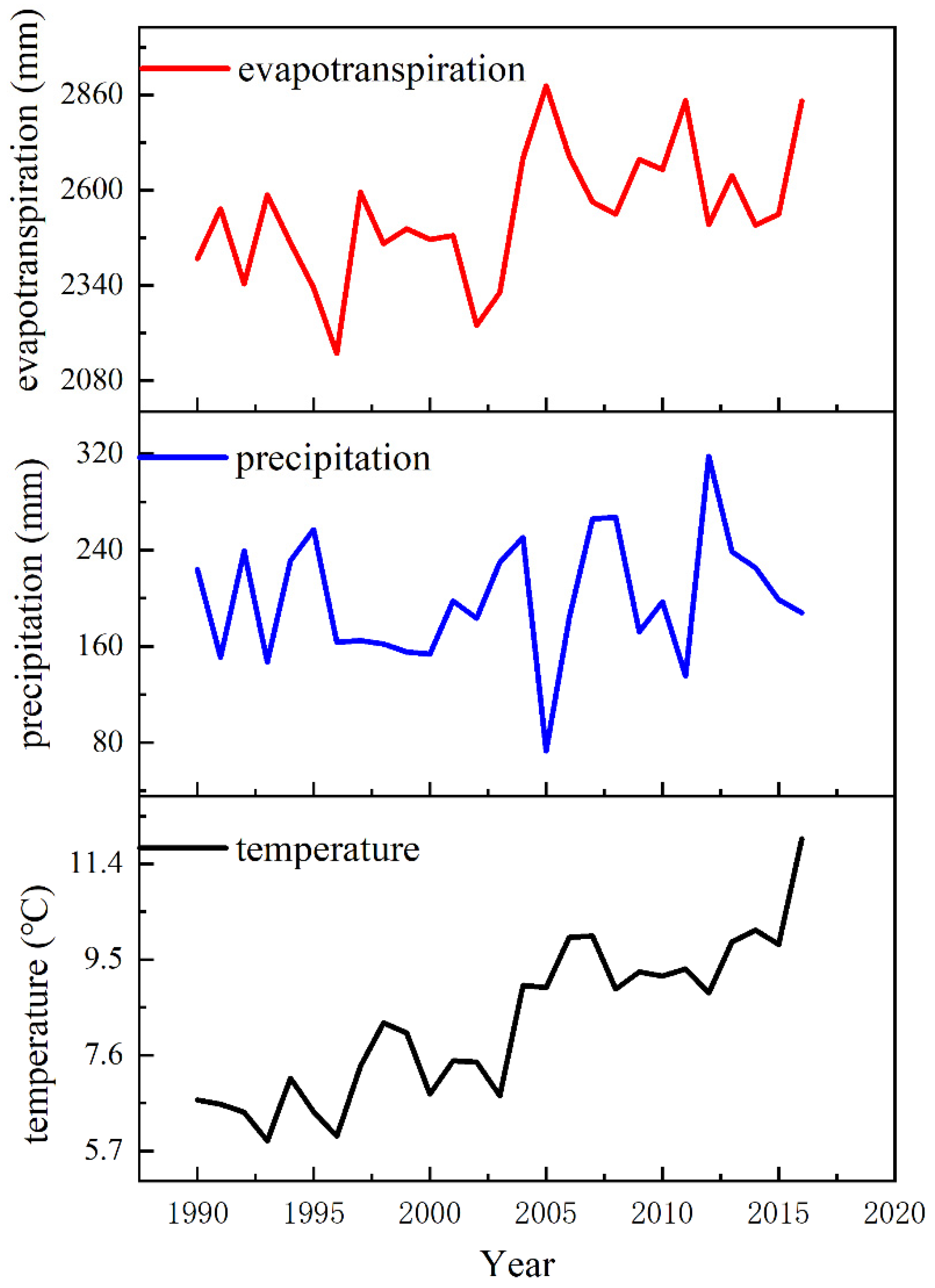
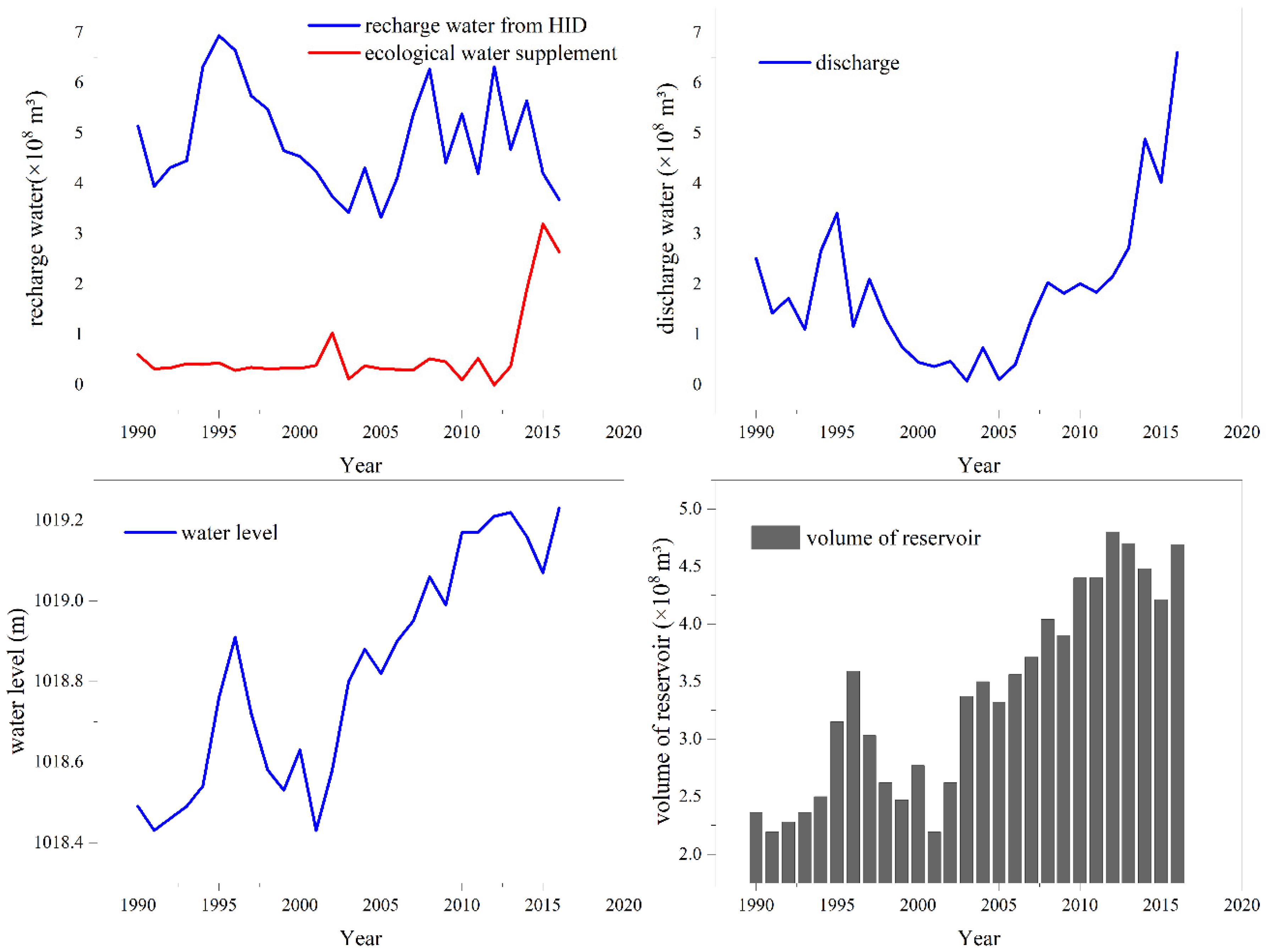
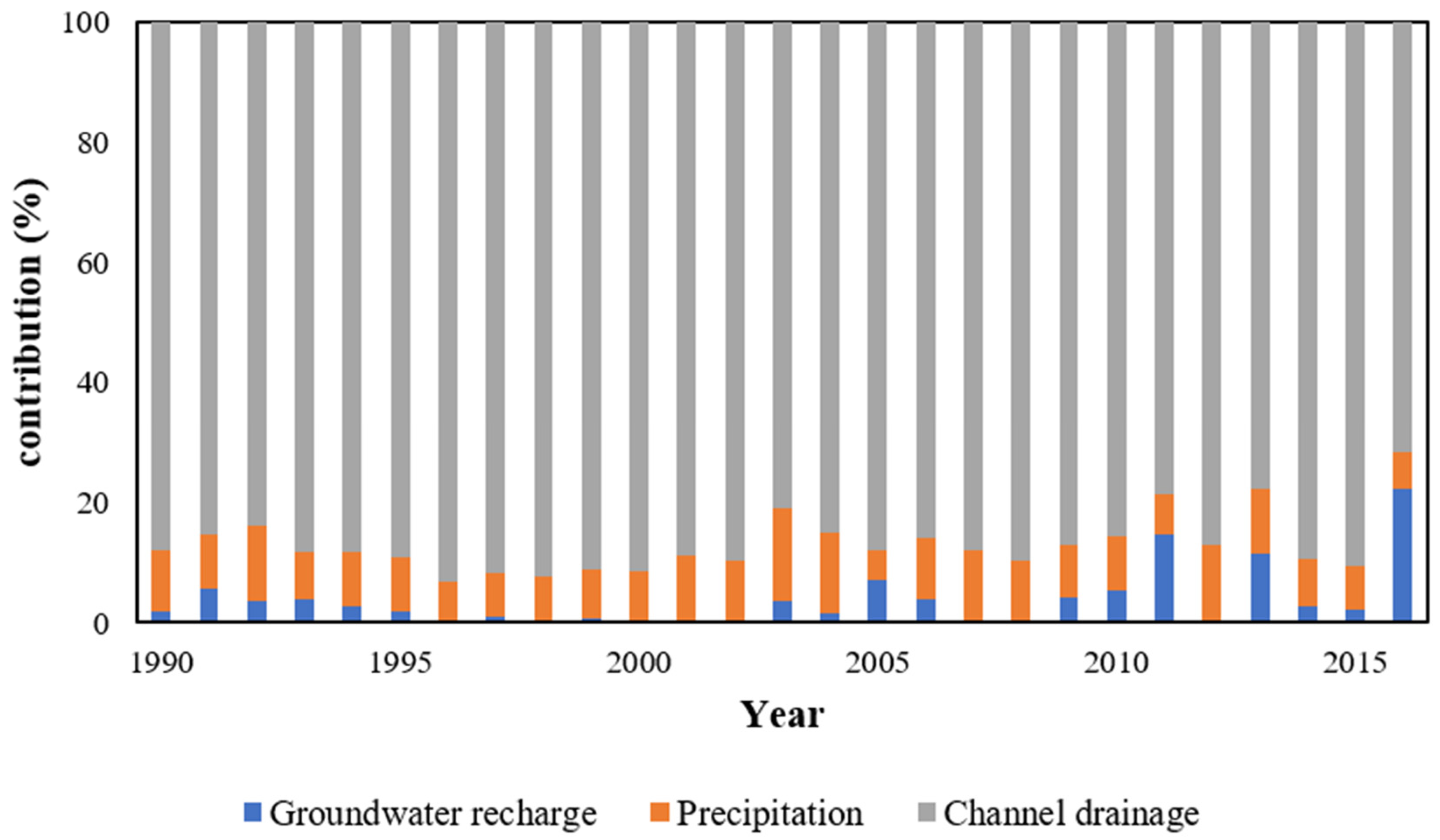
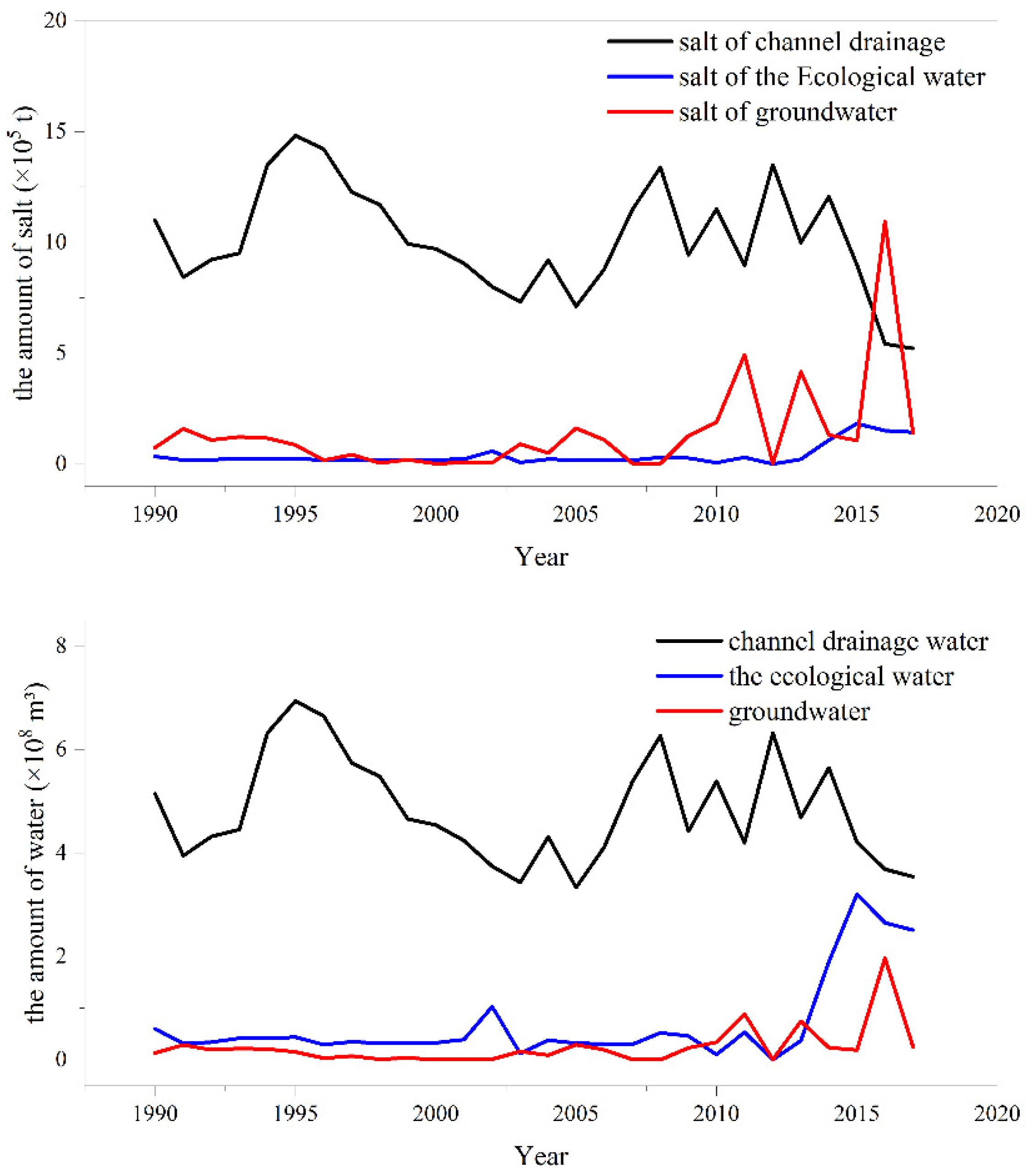
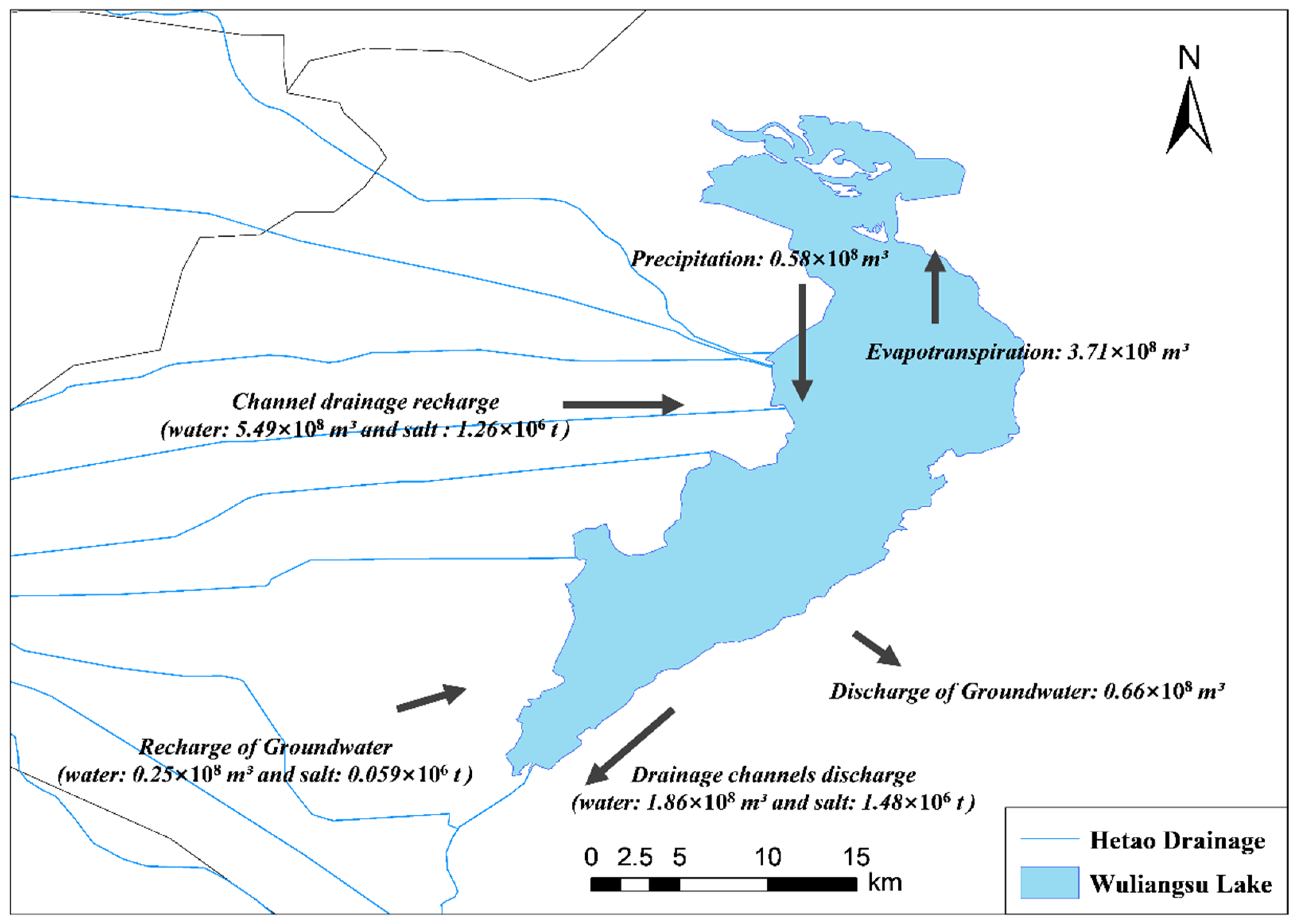
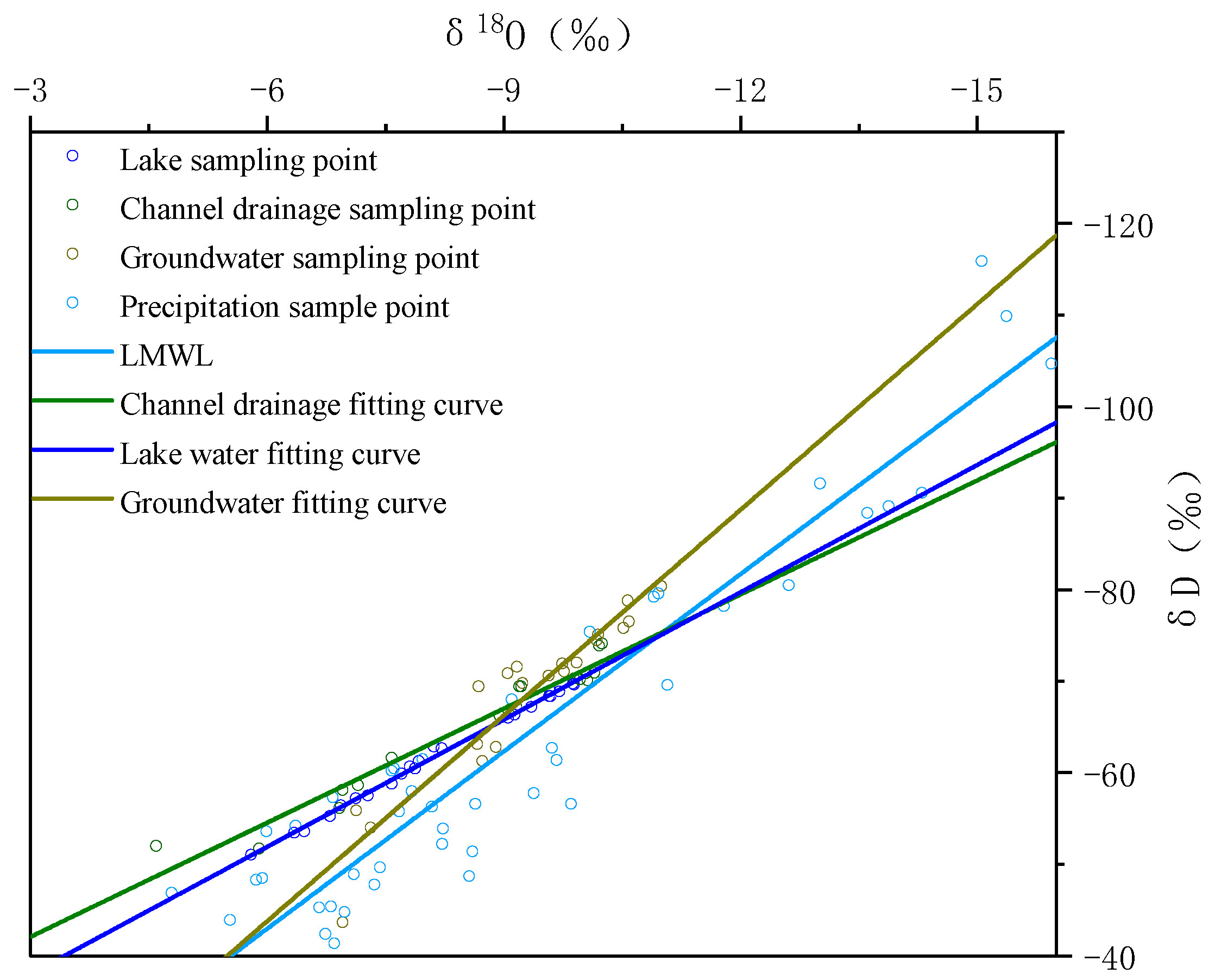
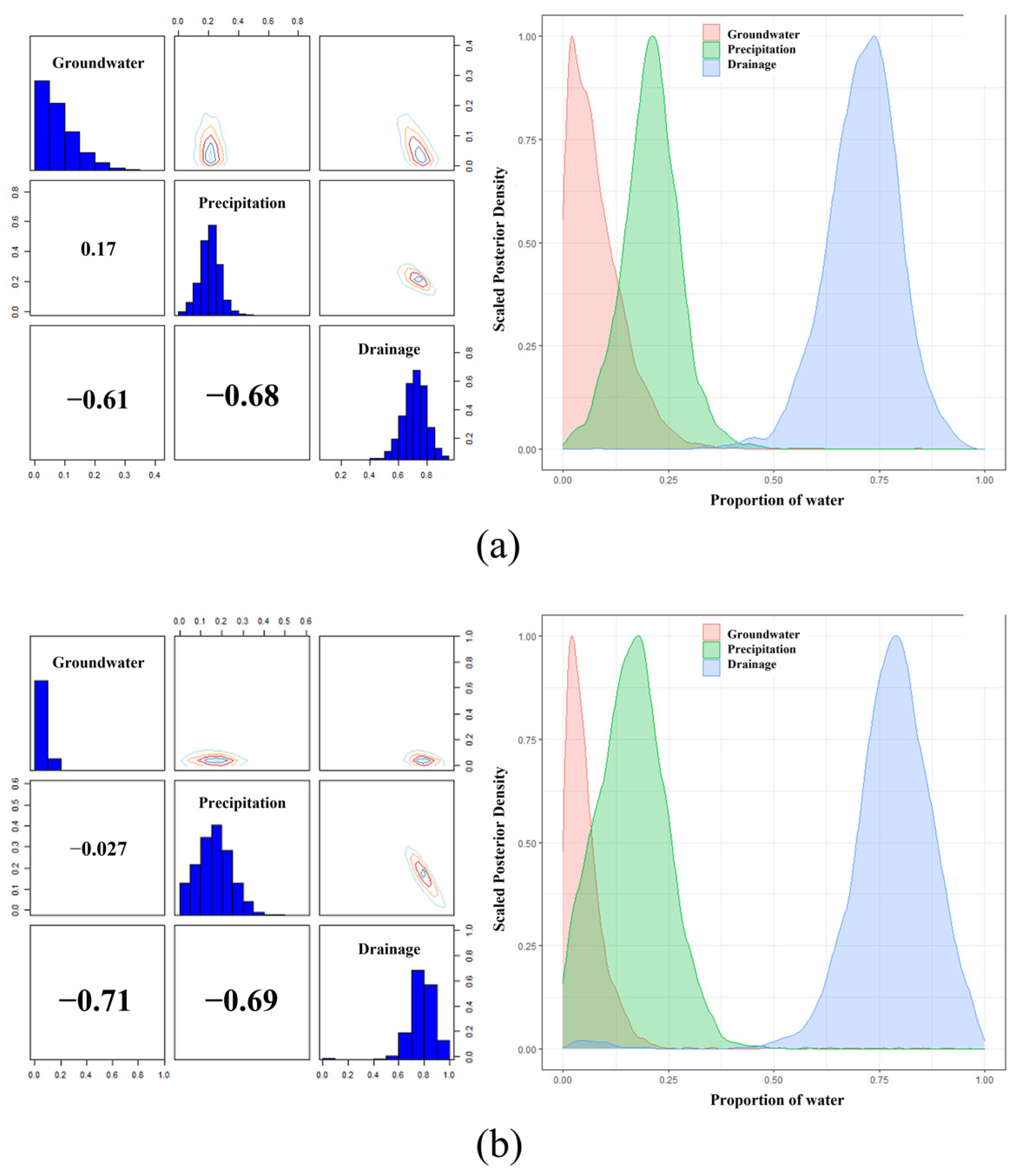
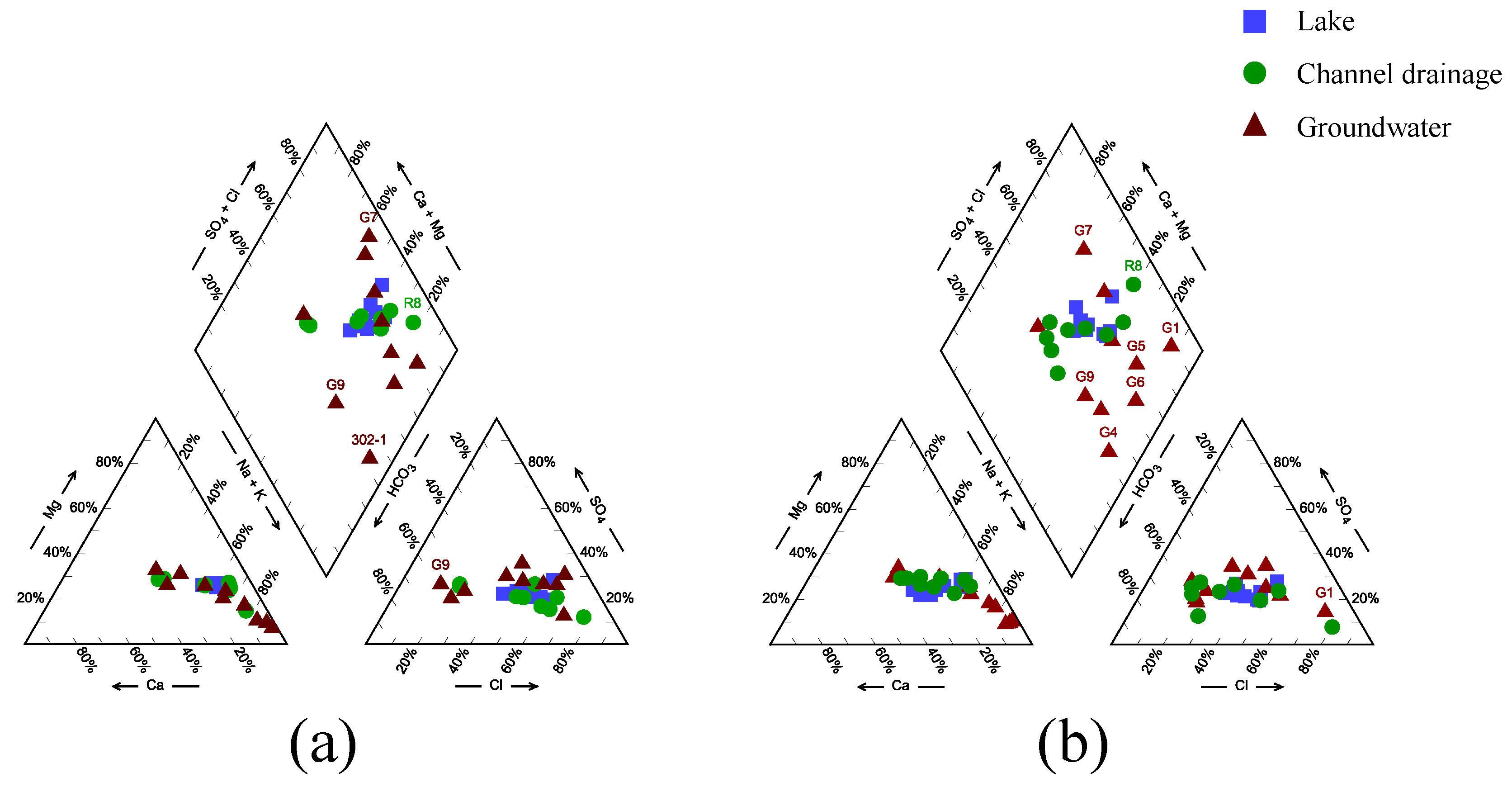
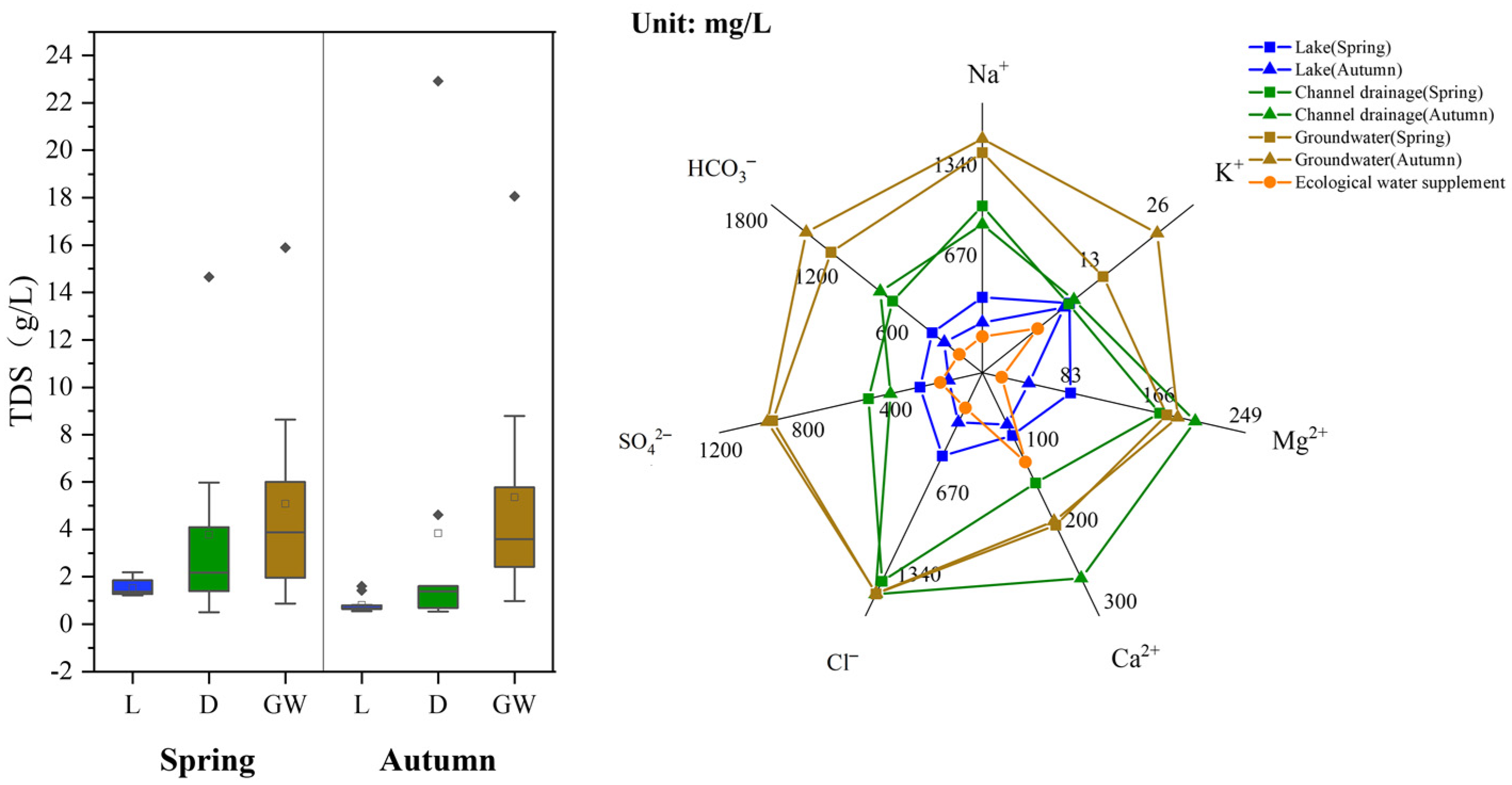

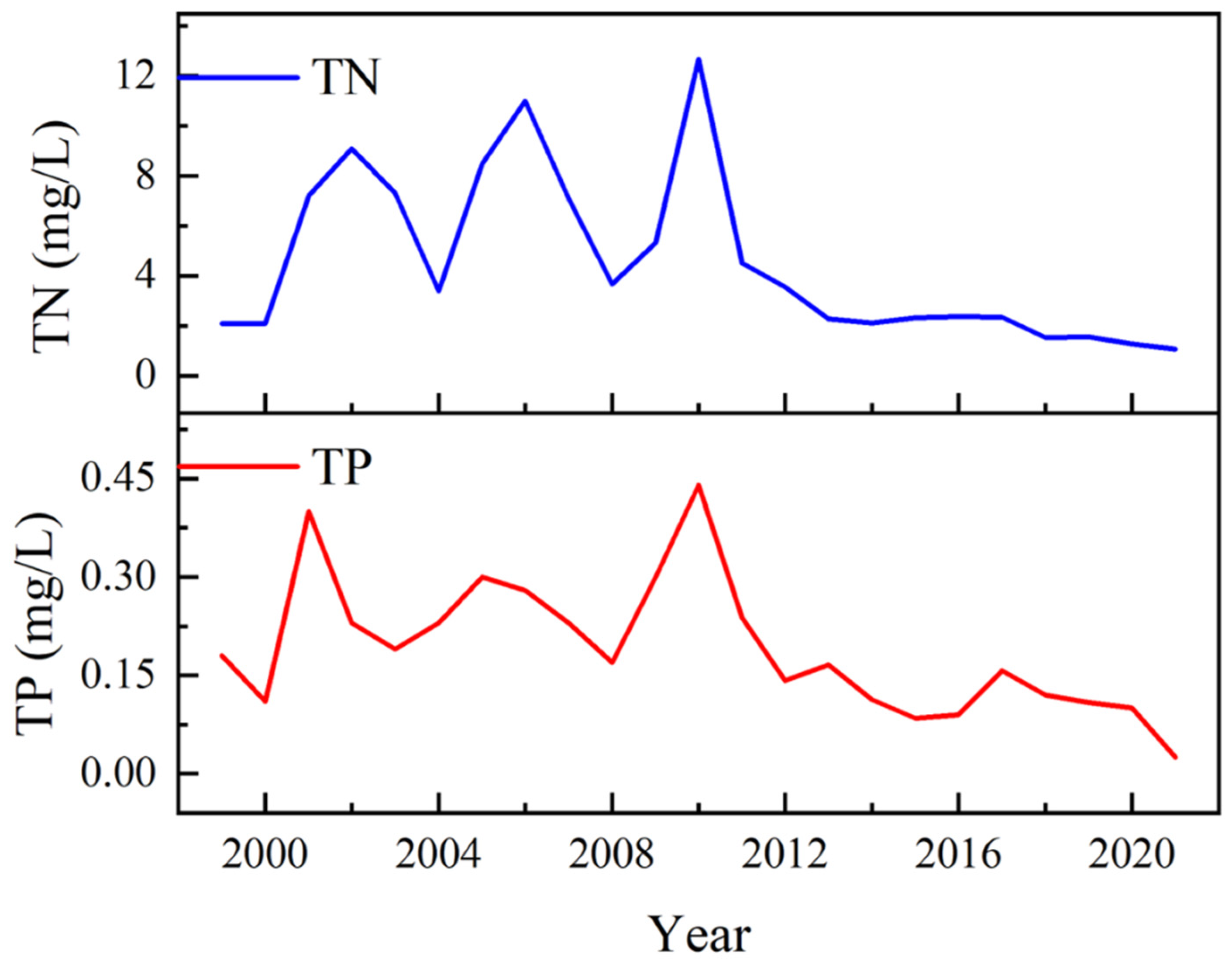
| Water Recharge Types | Water Recharge Amount (Unit: 108 m³) | Water Discharge Types | Water Discharge Amount (Unit: 108 m³) |
|---|---|---|---|
| Channel drainage | 5.49 | Channel drainage | 1.86 |
| Precipitation | 0.58 | Evapotranspiration | 3.71 |
| Groundwater | 0.25 | Groundwater seepage | 0.66 |
| Total | 6.32 | Total | 6.23 |
Publisher’s Note: MDPI stays neutral with regard to jurisdictional claims in published maps and institutional affiliations. |
© 2022 by the authors. Licensee MDPI, Basel, Switzerland. This article is an open access article distributed under the terms and conditions of the Creative Commons Attribution (CC BY) license (https://creativecommons.org/licenses/by/4.0/).
Share and Cite
Cao, C.; Li, N.; Yue, W.; Wu, L.; Cao, X.; Zhai, Y. Analysis of the Interaction between Lake and Groundwater Based on Water–Salt Balance Method and Stable Isotopic Characteristics. Int. J. Environ. Res. Public Health 2022, 19, 12202. https://doi.org/10.3390/ijerph191912202
Cao C, Li N, Yue W, Wu L, Cao X, Zhai Y. Analysis of the Interaction between Lake and Groundwater Based on Water–Salt Balance Method and Stable Isotopic Characteristics. International Journal of Environmental Research and Public Health. 2022; 19(19):12202. https://doi.org/10.3390/ijerph191912202
Chicago/Turabian StyleCao, Changming, Na Li, Weifeng Yue, Lijun Wu, Xinyi Cao, and Yuanzheng Zhai. 2022. "Analysis of the Interaction between Lake and Groundwater Based on Water–Salt Balance Method and Stable Isotopic Characteristics" International Journal of Environmental Research and Public Health 19, no. 19: 12202. https://doi.org/10.3390/ijerph191912202
APA StyleCao, C., Li, N., Yue, W., Wu, L., Cao, X., & Zhai, Y. (2022). Analysis of the Interaction between Lake and Groundwater Based on Water–Salt Balance Method and Stable Isotopic Characteristics. International Journal of Environmental Research and Public Health, 19(19), 12202. https://doi.org/10.3390/ijerph191912202








